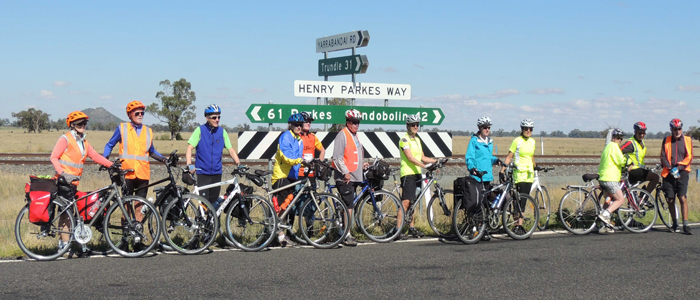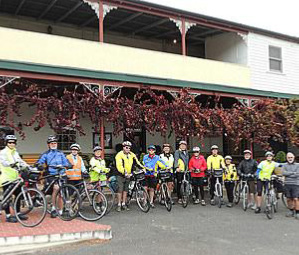
CYCLING GRADES
To provide participants with a guide to the level of difficulty of a proposed ride, the activity will be graded in the program on a scale of 1 to 6. Obviously there are many variables but the following can be taken as a guide:
Grade 1:
A ride of up to 30km on bike paths without hills
Grade 2:
A ride of up to 50km on bike paths and road roding with moderate hills
Grade 3:
A ride of up to 70km with mostly road riding and more significant hills
Grade 4 – 6:
These gradings will reflect various factors but mostly will come down to the duration of the ride (distance and days) and the terrain to be covered. It could also reflect the average speed that the activity organiser wishes to achieve.
CYCLING GUIDELINES
Most activities can be undertaken on a mountain, hybrid or road bike. Participants are responsible for  providing and maintaining all equipment. The Club does not have any cycling gear for loan. Due to road conditions and gear to be transported a road bike may not always be suitable and this will be noted in the program or advised by the activity organiser.
providing and maintaining all equipment. The Club does not have any cycling gear for loan. Due to road conditions and gear to be transported a road bike may not always be suitable and this will be noted in the program or advised by the activity organiser.
Before coming on a ride it is expected that the participant will have the necessary skill, equipment and fitness to undertake the activity. If unsure on these aspects please discuss with the activity organiser. Cycling activities are not suitable for children.
Please contact the activity organiser directly to book. For a day activity this should be at least several days before the event. For longer activities, book in as early as possible to avoid disappointment. All activities could have a limit on numbers due to safety, accommodation restrictions, transportation etc. The activity organiser will provide advice on other factors that will influence the difficulty of the event. These could include expected weather conditions (as wind, rain and temperature can make a big difference to the degree of difficulty of a ride) and road conditions. Please note that visitors cannot participate in multiday activities.
GENERAL
The activity organiser is responsible for ensuring that, as far as practicable, the requirements of this code are followed. The code covers four items Club rules, the bike, the cyclist and cycling.
- Every cyclist must have, and wear at all times, a helmet that conforms to the relevant Australian Standards or International equivalent. The activity organiser must refuse to allow a person, who does not have a helmet or declines to wear one, to participate in a ride. Any person who refuses to follow this directive but takes part in the ride will not be considered to be part of the Club activity for insurance purposes. The only exception will be, with the approval of the activity organiser, if the helmet is damaged, lost or stolen in the course of a ride.
- Every bike shall have a working bell properly installed and easily accessible for use.
- The bike should be in good working order and periodically checked for wear and, if necessary, repaired. Any safety related parts, for example brakes, should always be in good working order.
- In all cases the bike must be in good roadworthy condition. In addition it is expected that all participants will come equipped with helmet, pump, spare tube, tube repair kit, tyre levers, set of allen keys and lights if appropriate. Rainwear, first aid kit and water should always be brought along with other clothing and food as appropriate for the event.
THE CYCLIST
- Must carry PHOTO ID or fines will apply from RMS
- Should always carry a working pump with attachments appropriate for the valves on the tubes used.
- Should bear in mind, at all times, that cycling ways are to be shared with others. This applies to roads, footpaths, cycleways, shared paths, etc. When approaching others from behind sound the bell and do not speed, particularly where pedestrians, children or domestic pets may be present.
- Should be familiar with the proposed trip and feel confident of being able to ride the full distance unless arranging a shortened version with the approval of the activity organiser.
- Should follow all reasonable decisions by the activity organiser.
- Should wear clothing that is as visible as possible that is, bright (yellow or white) iridescent shirts or jackets.
- Should carry protective clothing suitable for weather changes and, preferably, a jacket with iridescent stripes to maximise visibility in poor light, poor weather or if caught out after dark.
- Should consider carrying a flashing lamp of the type that can be fastened to the rear of jackets or bike seats in case a ride finishes after dark.
CYCLING
- Cycle in a responsible manner always being mindful of other cyclists, possible motor traffic and possible pedestrians.
- Where possible cycle on sections of road or track marked for cyclists and, where there no marked lanes, keep as far left as practical.
- Do not speed on shared ways.
- When stopping for any reason clearly signal or call your intention and be sure to get out of the way of other riders, or vehicles, as rapidly as possible don’t force people to swerve or brake suddenly.
- In traffic always ride in single file.
- Always overtake on the right and always advise the person being overtaken of your plan.
